-
Is Interior Waterproofing Different from Exterior Waterproofing?
Is Interior Waterproofing Different from Exterior Waterproofing?
As a homeowner, the state of your home is important to you. Not only because it’s a big financial investment, but also because it is your home. Remember how excited you were the day you signed on the dotted line and received your keys? Why wouldn’t you put in the time and effort to make sure your home is in nearly perfect condition?
If you live in an area prone to heavy rainfall, snowstorms and heavy snow melts, then you are aware of the damage this kind of weather can bring to your home and your basement. Being the responsible homeowner that you are, you have decided to invest in basement waterproofing for your home. But there are so many options to choose from and there are various methods of basement waterproofing to think about. You also have to think about hiring a professional to do the job for you. And honestly, is interior waterproofing different from exterior waterproofing? Well, let’s find out shall we?
The Difference Between Interior and Exterior Waterproofing
Exterior Waterproofing
Exterior waterproofing is the first defense against water and consists of gutters and downspouts that collect water and lead it away from your home. This is why it is so important to always keep your gutters clean. Another important part of exterior waterproofing includes a waterproof membrane, which is installed around the foundation of your home to seal out moisture so that the concrete doesn’t absorb it, crack and allow leaks. Next is an exterior drainage system, like a French drain. This system can require some work because it requires excavation along the foundation of the home.
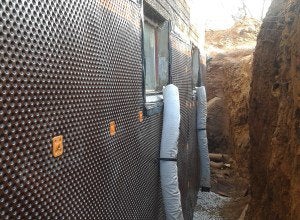
Drain tiles are fitted into the trench around the home, surrounded by gravel and then the entire system is covered with soil. The drain tiles will carry water away from the foundation before it has a chance to enter the basement. Although this method does involve some excavation, it can be well worth it.
Exterior waterproofing is also more expensive than interior waterproofing, because it requires more work and more material, but it efficiently stops water from getting close to the foundation of your home. When your foundation stays dry, it doesn’t get weak and damaged and it won’t crack to allow water leaks inside your basement or your home. So in turn, a pricy exterior waterproofing system ends up being reasonable, because it saves you money in the long run.
Interior Waterproofing
Interior waterproofing makes sure that water that leaks into the basement is re-routed out and away from the home. These interior drainage systems are made up of pipes and drains that catch leaks or are installed under the foundation to collect excess groundwater. This excess water is directed to a sump pit, which is basically a large basin that stores water in your basement. Then comes a sump pump, which is a water pump that sits inside the sump pit and pumps water out of the basement and away from your home. Sump pumps usually begin automatically pumping water when it reaches a certain level in the sump pit. Most sump pumps come with a back-up battery so they can continue working in case of a power outage or during a severe storm.
Another method of interior waterproofing is made up of vapor barriers. These are made up of plastic or foil sheets and are installed along the walls of your basement to seal out moisture. Apart from an interior drainage system, interior waterproofing also works to seal any cracks and leaks that are letting water into the basement. These can easily be sealed so that they don’t allow any moisture or humidity to accumulate in your home. Investing in a good interior waterproofing system can greatly reduce the risk of a flood in your basement. These drainage systems are easy to install and generally cost less than exterior waterproofing systems.
Interior and exterior waterproofing both have their pros and cons. Interior waterproofing can only be used to remove water that has already accumulated in your basement, so they are not effective at preventing water from coming getting into the basement in the first place. Exterior waterproofing can be expensive, but it keeps water away from your foundation and from getting inside your home or into your basement. Regardless of the method you decide on, what’s important is that you are making the effort to keep your home warm and dry. If you have any questions about waterproofing methods, or if you are interested in interior and exterior waterproofing for your home, contact the experts at Triad Basement Waterproofing for more information.
-
What Causes Concrete Foundation Cracks?
What Causes Concrete Foundation Cracks?
Although our homes are built to be resilient to many things, after some time they tend to wear down. In the same way we show signs of age through wrinkles, our homes show it through imperfections and cracks. With the flaws of imperfect construction, pressure surrounding the home and the weight of the house bearing down on it, the foundation of your home takes it all. When it comes to foundation cracks or repairs, the important thing is to take care of the issue as soon as possible. It’s not a good idea to forget about it and wait until the crack gets bigger and allows water to leak into your basement and flood your home.
All concrete has the tendency to crack and there is no way to produce crack-free concrete. Concrete expands and shrinks with changes in temperature and moisture and this can cause cracking early on. Often concrete foundation cracks are not detected until long after they’ve formed. Regardless of how long the crack has been there, it tends to concern homeowners and they worry about the imperfection.
Cracks in concrete foundation most often appear at weak points like corners, basement window frames, walls and pipe areas. It’s important to keep track of these cracks and notice if they are getting bigger. It’s also important to understand why the crack showed up in the first place. What causes concrete foundation cracks? Read on to find out!
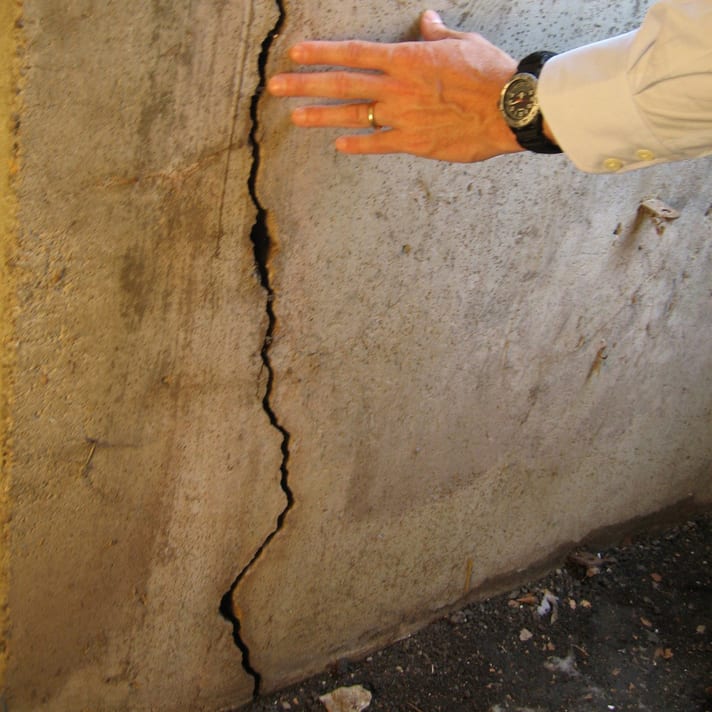
Top Causes of Concrete Foundation Cracks
Drought or too much moisture
Soil shrinks like a sponge when moisture is removed from it and when that happens it pulls away from the foundation of your home creating a gap. This gap allows for the foundation to move. When the foundation of a home is not supported properly it can shift around and cracks will begin to appear. In turn, if there is too much moisture it will cause the soil that is supporting the foundation of your home to expand.
Earthquakes
When an earthquake occurs it causes the ground to shake, which in turn shakes your home around. Thankfully not too many earthquakes occur on this side of the U.S., however even the tiniest of quivers can be an issue. Remember, if the foundation isn’t supported or stable, it can move around, weaken and crack. A small earthquake may not cause new cracks, but it can intensify ones that are already present.
Storms
Whether you experience a hurricane, a nor’easter or just a typical rainstorm these storms produce a lot of water, which can damage the foundation of your home. Too much water will force the soil around the foundation of your home to expand, which will push up against the home and cause concrete foundation cracks. Storms can also cause various other structural problems if you don’t take preventive measures to secure your home. One of the most popular explanations behind concrete foundation cracks is the freeze and thaw cycle during the winter. Concrete freezes at around 18 degrees and then it melts at around 35 degrees, which is when the cracking develops.
Plumbing Leaks
It’s important to make sure your pipes are secured and aren’t leaking and that you don’t have any plumbing leaks in your home. If you’re home isn’t equipped with basement waterproofing or a sump pump, the excess water will add to the soil causing it to expand and push against your foundation.
Flooding
Regardless of whether the flooding comes from a storm, a leak, inadequate drainage or something else, too much water will be a problem for your concrete foundation. When hydrostatic pressure becomes too much for the foundation of your home you will notice more leaks, more cracks and more problems.
Extreme Heat
Concrete can also crack under extreme sun and heat because it causes the concrete to expand. During the day and under the sun the concrete will expand, and then overnight the concrete will shrink and retreat back to its original unbaked position.
Get Help Fixing Your Cracks
The moral of the story is that it is important to keep your foundation stable, dry and supported.
When your foundation has wiggle room due to dry soil or if it’s tightly pushed in by expanding soil, these movements cause it to weaken and in turn create concrete foundation cracks. The good news is that concrete foundation cracks that are a result of too much moisture and flooding can be prevented through various methods of basement waterproofing.
It’s also not too difficult to repair concrete foundation cracks with epoxy injections. If you are thinking about preventive measures or you need concrete repair, then contact the team at Triad Basement Waterproofing and they will create a custom solution to your specific situation.
-
Top 3 Methods of Basement Waterproofing
Top 3 Methods of Basement Waterproofing
Are you suffering from a wet basement? Or are you looking for precautionary measures to help prevent basement flooding in your home?
Regardless of the motivation, it’s a good idea to invest in basement waterproofing for your home so you can protect what is yours, prevent any damages as well as save money instead of spending it on fixing a ruined basement or replacing damaged belongings.
If you are trying to figure out a way to cure a wet basement, or how to prevent one from happening then you are probably curious about the products and methods behind basement waterproofing. It is possible to dry out a basement and keep it that way with waterproofing, drainage and sealants, but you need to make sure you are choosing the right method, materials and contractors for your specific situation.
Each basement and situation is different so it is important to know where the moisture could potentially come in from and to create a comprehensive solution that is going to last. There are really only three methods to basement waterproofing – interior, exterior and drainage.
Let’s find out more about the top three methods of basement waterproofing .
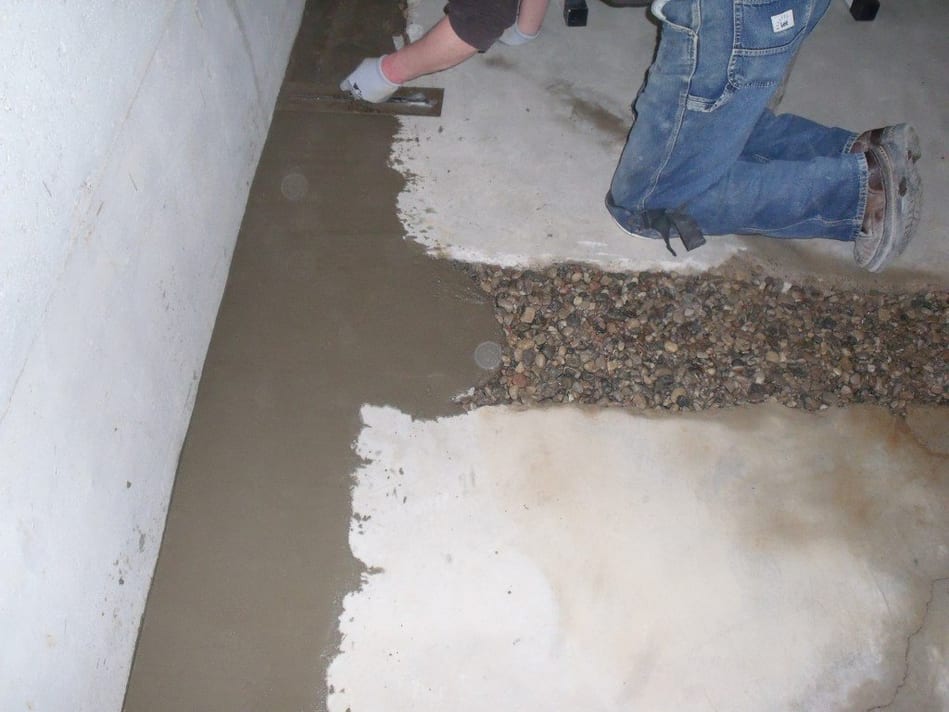
Interior Sealants & Waterproofing
The most common entry point for water is through cracks in the concrete foundation. The good news is that these cracks can be easily sealed from the inside.
Special sealants are injected into the opening, penetrating through to the exterior where they seal the path off to potential moisture and leaks. These sealants usually last for a long time and come with long warranties. Although interior sealers are good for preventing leaks and humidity, they won’t work perfectly if there is strong hydrostatic pressure (water pressure) pushing against the foundation.
Using waterproof coatings on the inside of your basement is also a good idea. Concrete waterproofing coatings adhere permanently to concrete walls and work well where there is a minor dampness or condensation issue. Sealants and waterproof coatings cannot fix major leaks or basement floods.
Exterior Waterproofing
Exterior waterproofing helps to prevent water from entering your home to begin with so that the moisture doesn’t damage the foundation or the inside of your basement.
This method is accomplished by fully excavating around the home to the bottom of the foundation. Once that is done, the walls are sealed with a waterproof coating, which will waterproof the walls and direct water down to a drain system.
The drain can then be directed to a sump pump or down a slope that leads away from the foundation. This method will efficiently stop water from entering into your home and basement through the walls or through the foundation.
Interior & Exterior Drainage
If water did somehow make it into your home through a leak, then a proper drainage system is a great way to keep water under control. The easiest way to utilize drainage inside your basement is to have a sump pump that collects the water from inside and then pumps it out away from your home.
Interior drainage systems function by draining underground water from alongside the foundation of your home and then pump it away from the basement. These drainage systems should be prepared to work in case of a power outage, an overwhelming rainfall or heavy snowstorm and snow melt.
Water drainage is an efficient solution to keeping water out of your home and basement and they can also be airtight and used with vapor barriers to keep the area free from dangerous mold and mildew.
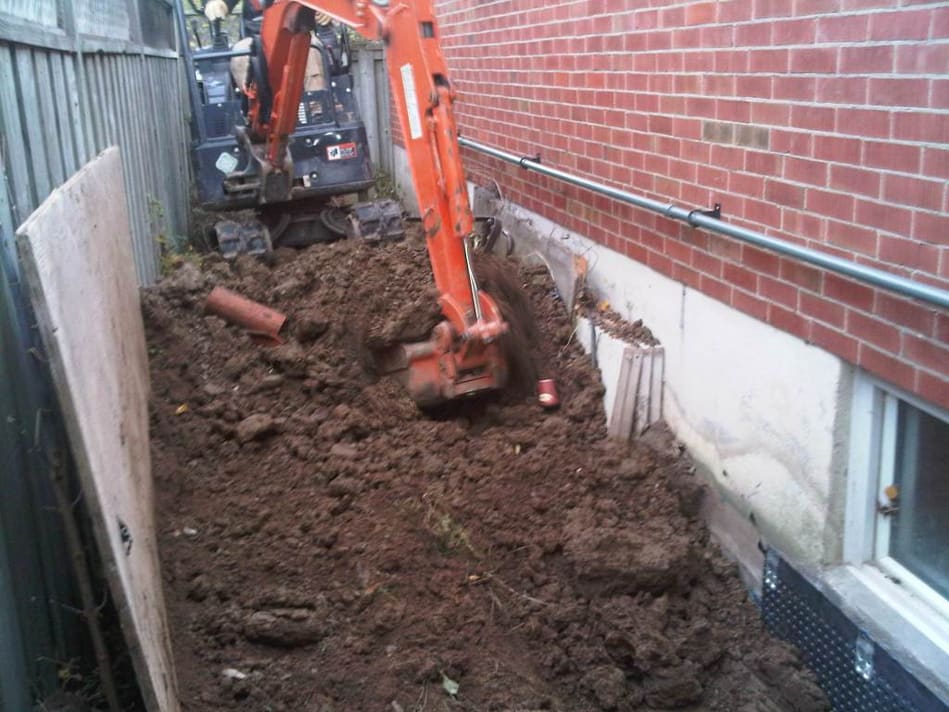
Which Method is the Best?
Nobody wants to come home to a flooded or leaky basement, so it is important to take preventive measures ahead of time and to be prepared in case a leak does occur.
There is no one best way to protect your home from leaks and moisture, because each situation is different. For some homes a coat or two of a waterproof sealant may be enough, while others may need a drainage system as well as a waterproof sealant.
When you work with Triad Basement Waterproofing, we will thoroughly analyze your basement, your foundation and your home and compose a unique solution to your issues. We not only waterproof your home, but we also make sure to relieve the water pressure from outside your home.
Apart from waterproofing your basement there are also other things you can do to help keep your home warm and dry.
Check out some of these tips to prevent a flooded basement.
We offer our professional services throughout Maryland, Pennsylvania, Virginia and Washington, DC. If you need basement help or you are thinking about basement waterproofing then contact our experts at Triad today!
-
How to Prevent a Flooded Basement in the Winter
How to Prevent a Flooded Basement in the Winter
Winter is upon us and that means that it is very important to protect our basements from any flooding this year. Heavy snow, heavy rain and in turn heavy snowmelts are extremely threatening to unprotected basements. Many people believe that the rainy season is the worst time of year for a basement. While heavy rain does pose a high threat to unprotected basements, winter and snow can be worse.
When the temperature of the ground is above freezing the accumulated snow instantly melts and turns into water, which has the same effect as rain. If the temperature of the ground is below freezing, snow will accumulate and as soon as the temperature rises it can turn into a heavy stream of water pounding against the foundation of your home. When water accumulates around your home, the water can seep through any porous surfaces, cracks in the foundation, window wells, etc.
You know how a quick change in temperature from cold to hot can crack glass?
Big temperature changes can do the same thing to your foundation, weakening it over time and allowing water to flow freely into your basement. The last thing you want to do is walk into a flooded basement during the cold winter months! Don’t wait till winter to invest in basement waterproofing, the colder weather makes it tough to work outside, so it is important to take care of the work before the temperatures drop.
Here are some tips from the professionals at Triad Basement Waterproofing that will show you how to prevent a flooded basement in the winter.
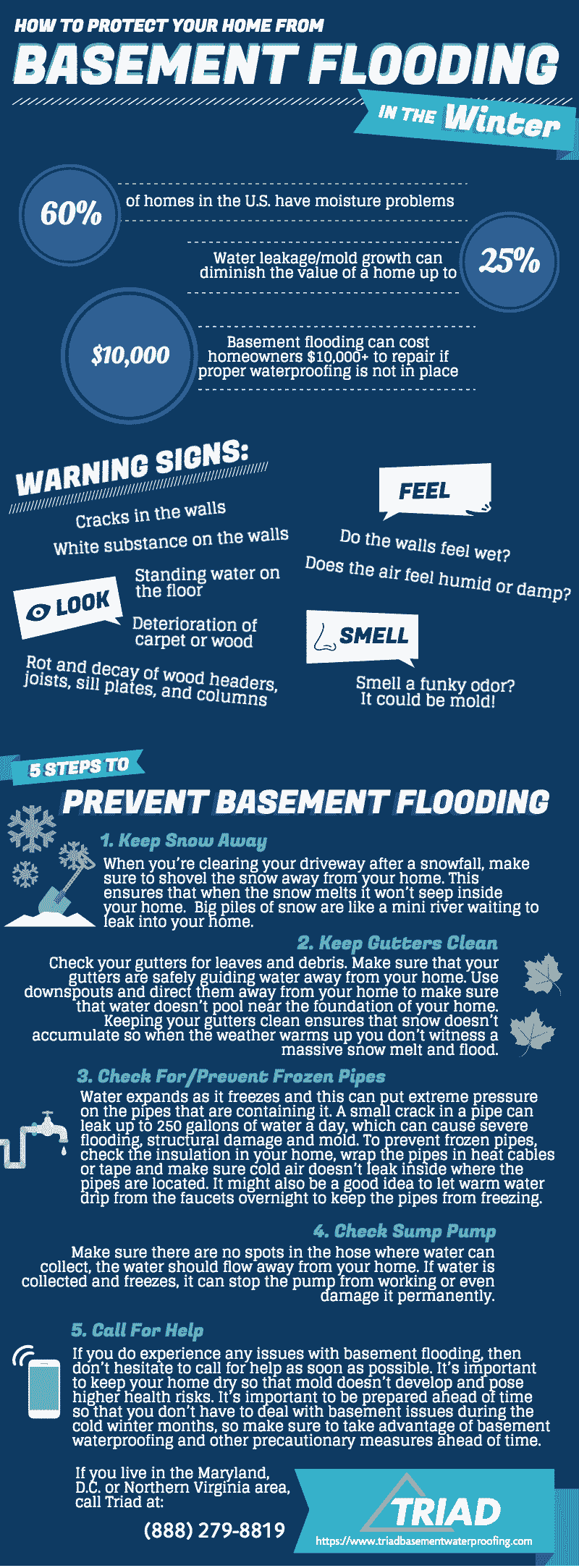
- Keep Snow Away From Your Home
When you’re clearing your driveway after a snowfall, make sure to shovel the snow away from your home. This ensures that when the snow melts it won’t seep inside your home. Big piles of snow are like a mini river waiting to leak into your home.
- Keep Your Gutters Clean
Keeping your gutters clean is something you should be doing throughout the year anyway. Before winter comes around check your gutters for leaves and debris. Make sure that your gutters are safely guiding water away from your home. Use downspouts and direct them away from your home to make sure that water doesn’t pool near the foundation of your home. Keeping your gutters clean ensures that snow doesn’t accumulate so when the weather warms up you don’t witness a massive snow melt and flood.
- Check for & Prevent Frozen Pipes
Water expands as it freezes and this can put extreme pressure on the pipes that are containing it. Pipes that freeze often are those that are exposed to severe cold such as swimming pool supply lines, sprinklers, outdoor faucets and other pipes housed in unheated areas like the basement, garage or attic. A small crack in a pipe can leak up to 250 gallons of water a day, which can cause severe flooding, structural damage and mold. To prevent frozen pipes you can check the insulation in your home, wrap the pipes in heat cables or tape and make sure cold air doesn’t leak inside where the pipes are located. It might also be a good idea to let warm water drip from the faucets overnight to keep the pipes from freezing.
- Check Your Sump Pump
Double check your sump pump before winter rolls around. Make sure there are no spots in the hose where water can collect, the water should flow away from your home. If water is collected and freezes, it can stop the pump from working or even damage it permanently.
- Call for Help!
If you do experience any issues with basement flooding, then don’t hesitate to call for help as soon as possible. It’s important to keep your home dry so that mold doesn’t develop and pose higher health risks. It’s important to be prepared ahead of time so that you don’t have to deal with basement issues during the cold winter months, so make sure to take advantage of basement waterproofing and other precautionary measures ahead of time.
Coming home to find your basement flooded is never fun, but experiencing flooding during the cold winter months can be brutal. The winter season is supposed to be warm and cozy and there’s nothing like a flooded basement to ruin the whole experience for you and your family. It’s important to know what to look for and how to prevent a flooded basement in the winter. Triad Basement Waterproofing has more than 27 years of experience dealing with basement water problems and the experts here can help insure that your home stays dry at any given time of the year. Check out our website for a full list of services and contact us if you have any questions !
-
What is Concrete Resurfacing?
Concrete Resurfacing by Triad Basement Waterproofing
As a proud homeowner, you strive to care for your property, so it always looks and functions its best. As you assess the structures and features around your home and yard, one thing that might stick out is the old, cracked concrete. You may not be eager to pay for a replacement, but this eyesore is starting to wear on you.
That’s where concrete resurfacing comes in. This restoration technique revives worn or damaged concrete surfaces without completely replacing them. It’s a cost-effective solution that involves applying a thin layer of concrete overlay or coating to existing concrete, enhancing its appearance, durability, and functionality. Suitable for basements, driveways, patios, and sidewalks, concrete resurfacing offers a sustainable way to extend the lifespan and improve the appearance of concrete surfaces throughout your property.
Why is Concrete Resurfacing Necessary?
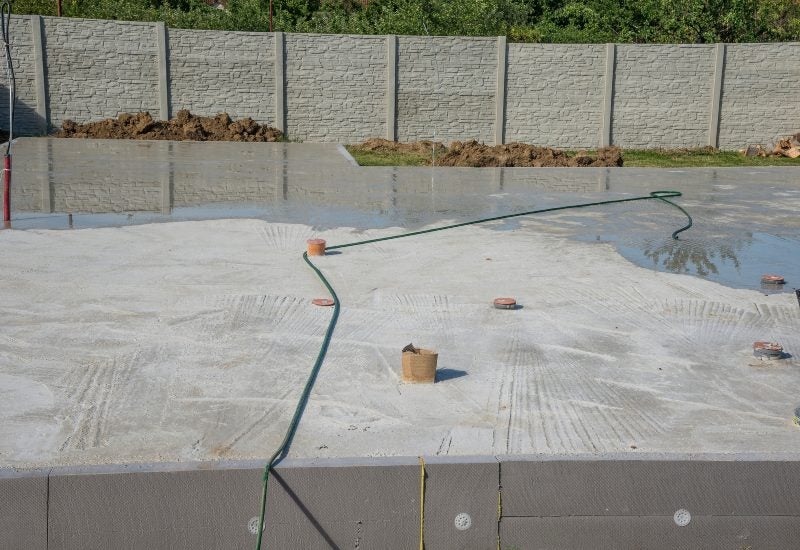
Concrete is subject to wear and tear over time due to foot traffic, weather, and other environmental factors, leading to cracks, stains, and a worn-out appearance. Concrete resurfacing solves these issues, providing a fresh top layer that makes the concrete look brand-new without the cost of a full replacement. You can even use this opportunity to customize the concrete’s color, texture, and pattern, creating the look of a completely new slab and improving your property’s aesthetics.
What is the Procedure for Concrete Resurfacing?
Whether you’re looking to resurface basement concrete or a concrete patio, the process is largely the same. Here are the key steps involved to ensure a successful application:
- Initial inspection and repair: The first step is to assess the concrete surface for any major damage. Repair cracks or holes larger than one-quarter inch deep or wide to ensure a smooth, structurally sound base for resurfacing.
- Cleaning: Thoroughly clean the surface using acid, detergent, or bleach, followed by pressure washing to remove any deteriorated concrete and ensure overlay adhesion.
- Preparation of the resurfacer: Mix the concrete resurfacer with water using a commercial-grade drill and mixer. A mechanical mortar mixer may be needed for later jobs. Follow the manufacturer’s instructions to achieve the correct consistency.
- Application: Apply the resurfacer in one-foot-wide strips using a long-handled squeegee. Work the product into the surface to ensure it penetrates the pores and achieves an even thickness.
- Finishing touches: After the resurfacer begins to set, use a broom to texture the surface for a non-slip finish if desired. Keep the surface moist for 24 to 48 hours to promote a strong bond and prevent shrinkage cracks.
What are the Advantages of Concrete Resurfacing?
Concrete floor or driveway resurfacing offers numerous benefits:
- Cost-effectiveness: Resurfacing eliminates the need to demolish and replace existing concrete, saving money on labor and materials.
- Quick turnaround time: The resurfacing process is much faster than laying new concrete, with areas often ready for traffic in just a few days.
- Customizable finishes: Even without a full replacement, you still have the flexibility to choose a new finish with coloring, stamping, or staining, making it easy to match any decor or landscaping theme.
- Durability: Resurfacing adds a strong top layer to the existing concrete, extending its lifespan and enhancing resistance to wear and tear.
- Low maintenance: The new surface requires minimal upkeep, saving time and money on future maintenance and repairs.
Does My Surface Qualify for Concrete Resurfacing?
Concrete resurfacing works best on areas with minor damage, so a thorough evaluation is required to determine if a surface is suitable for this restoration method. Excessive cracking is a concern because it might suggest deeper issues like ground movement, potentially causing the resurfaced layer to crack. Dusting and high moisture levels may also compromise the resurfacing process, leading to delamination or damage.
It’s important to note that resurfacing doesn’t solve structural problems, so replacing the concrete might be recommended in some cases. Even if your surface qualifies for concrete resurfacing, proper preparation and repair of large holes and pitting are essential for a successful finished product.
Contact Triad Basement Waterproofing in Gaithersburg, MD
At Triad Basement Waterproofing, we pride ourselves on delivering state-of-the-art, cost-effective concrete resurfacing and basement waterproofing solutions. Our local, family-owned business has been serving Gaithersburg, MD, since 1987. We are licensed, bonded, and insured professionals who provide the highest quality work with industry-leading warranties to back up everything we do. If you’re looking for concrete floor resurfacing inside or outside your home, please contact us at (301) 532-7903 to request a free estimate.
-
What to Do If Your Basement Floods
Solutions to Prevent Basement Flooding by Triad Basement Waterproofing
It’s raining pretty hard, so you decide to check on the basement. Discovering water pouring in from the window wells or slowing rising from the floor is shocking, but don’t panic. Prompt action is the best way to mitigate property damage and salvage your belongings. Here’s how to address basement flooding and prevent future water intrusion.
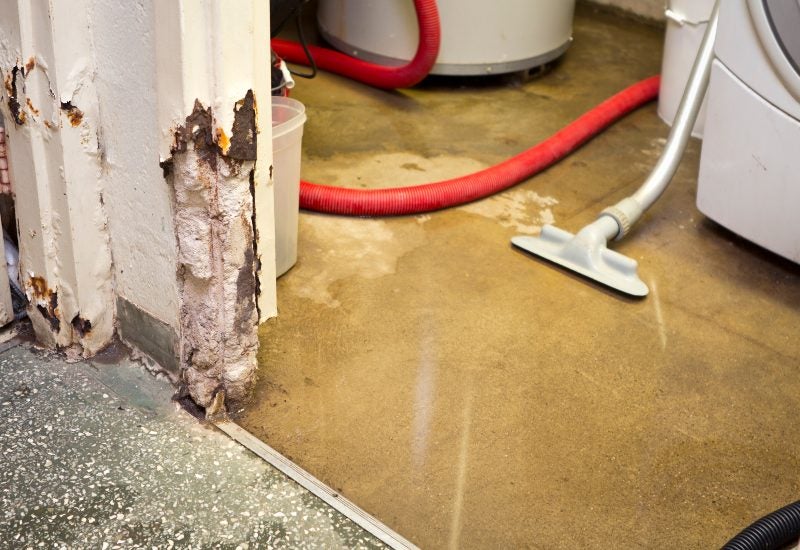
What Causes Basement Flooding?
Basements can flood for several reasons. Common causes include:
- Heavy rainfall: When intense rain over-saturates the soil around your home, the excess water may flow into your basement, especially if your property has poor drainage.
- Faulty sump pump: A sump pump is your first line of defense against basement flooding. If the pump fails due to a power outage, mechanical failure, or improper maintenance, water can quickly rise.
- Poor drainage: Clogged or improperly installed gutters and downspouts can cause water to spill over and collect near your basement, leading to floods. Soil that slopes toward your foundation rather than away from it is also an issue.
- Leaks: Cracked basement walls and floors allow rising groundwater to seep in. These leaks can form due to hydrostatic pressure from the soil outside your basement, especially after heavy rains or snow melts.
- Sewer backup: During heavy rainfall, municipal sewer systems can become overwhelmed, causing water to back up through the sewer lines. This can lead to sewage and water flowing into your basement through drains and toilets, posing serious health risks.
What to Do If Your Basement Has Flooded
Act promptly to minimize the damage from a flooded basement. Here’s what to do if your basement floods:
- Cut the power: To eliminate electrical hazards, turn off the power to the basement from your home’s main electrical panel. If you can’t access the panel safely or it’s located in the basement, call an electrician or your utility company for assistance.
- Identify where the water is coming from and stop it: If the flooding stems from a burst pipe, turn off your home’s main water supply. If the water is entering through foundation cracks, temporary sandbagging and waterproof taping may help.
- Take proper safety precautions: Wear rubber boots and gloves to safeguard against contaminated water. Remember, floodwater can contain harmful bacteria, chemicals, or sewage, so calling a professional for flooded basement cleanup is wise.
- Pump water from the basement: A sump pump can pump out large volumes of water. Direct standing water to the sump pit using a push broom, and the pump will do the rest. If you don’t have a sump pump, rent a wet-dry shop vac or pool pump. Direct the water into a drain, not your yard, where it will only further saturate the soil.
- Remove wet items: Take wet carpets, furniture, and boxes to a well-ventilated area to dry out. Sorting through these items quickly is important; some belongings may be salvageable, while others might need to be discarded due to water damage or mold growth.
- Air out and dry the basement: Good ventilation is the key to drying out a flooded basement. Use fans and dehumidifiers to circulate air and remove moisture. Only open windows if it’s dry outside to avoid introducing more humidity.
- Clean, sanitize, and deodorize: After the basement is dry, thoroughly clean and disinfect all surfaces to prevent mold. Clean nonporous surfaces with water and detergent, and sanitize with bleach to kill lingering bacteria. Porous materials may need to be professionally cleaned or discarded.
Prevent Future Basement Flooding
One instance of basement flooding is one time too many. Here’s how to fortify your basement against future water threats:
- Test your sump pump: Check the pump before the rainy season starts by pouring water into the sump pit. The pump should activate, pump out water, and turn off automatically. Consider a battery backup to ensure your sump pump works during power outages.
- Clean your gutters and downspouts: Clear leaves and debris from the gutters every spring and fall. Then, extend downspouts at least three feet away from your home to prevent water from pooling around the foundation.
- Install window well covers: Window wells can collect rainwater and snow, which then seep into your basement. Clear, domed window well covers allow light to enter while keeping out water, leaves, and debris.
- Invest in basement waterproofing: Waterproofing your basement reduces the risk of flooding. Interior waterproofing involves applying sealants, installing a drain tile system, and using a dehumidifier. Exterior waterproofing may include grading the soil, applying waterproof coatings or membranes to exterior walls, and installing pumps or French drains.
Contact Triad Basement Waterproofing in Gaithersburg, MD
At Triad Basement Waterproofing, we know nothing is more stressful than a flooded basement. Our local, family-owned business offers state-of-the-art, cost-effective solutions to keep your basement dry and safe. With over 35 years of experience, our licensed, bonded, and insured professionals ensure top-quality service with a personal touch. Plus, we stand by our work with industry-leading warranties for your peace of mind. Contact us at (301) 532-7903 for a free basement flooding repair or waterproofing estimate in Gaithersburg, MD.
-
What are the Benefits of Concrete Resurfacing?
Are your concrete surfaces looking old, worn or dirty? Whether you have concrete surfaces indoors or outdoors that are in need of refreshing, the look of dull concrete can affect the overall aesthetics of any home and irritate homeowners to no end. Many people will decide to rip out the concrete and have it completely redone from start to finish, or they will buy concrete mix and try to pour it on top of the old surface. The first option of starting fresh is not a bad idea, but it is completely unnecessary. The second option of pouring new concrete on top of old concrete is a very bad one. This doesn’t work as well as you would expect it to, because concrete does not contain bonding agents and it will not adhere to the surface beneath it. This results in crumbling and an even bigger headache for the homeowner. This is where concrete resurfacing comes in. What is concrete resurfacing? Simply put it’s a thin cement based overlay with special bonding agents that is poured over existing concrete. Here’s a quick guide that will fill you in on all the benefits of concrete resurfacing.
1. It’s Economical & Doesn’t Break Your Bank Account
In comparison to other solutions that fix worn out and cracked concrete, resurfacing is very cost efficient. The overall cost can be up to three times less than ripping up and replacingold concrete. You save money on the cost of materials and labor while still achieving the look of a brand new surface. Concrete resurfacing can also be used to repair old surfaces as well as hide damage, so you get more for your money. Whether you need a garage floor, basement floor, patio, deck or pool coated, concrete resurfacing saves you time, money and it leaves your surface looking brand new!2. It’s Easy to Apply & Saves Time
Resurfacing products are self-leveling, which means that there isn’t an extensive amount of work necessary to create a smooth and level surface. The main thing that needs to be done is to make sure that the resurfacing product is spread around the entire surface. Instead of spending time and money on trying to repair cracked concrete or ripping out an old surface and having it re-poured consider concrete resurfacing, which upgrades the look and hides any prior imperfections or cracks.3. It Allows for Different Designs & Colors for more Aesthetically Pleasing Finishes
Do you want a marble floor without paying the price of actual marble? Or maybe you prefer sandstone, brick, granite, or a specific color? The beauty of concrete resurfacing is that it can be tinted with special colorants or stamped with patterns or finishes. This allows you to customize your concrete floors and achieve the design and ambiance you’re specifically looking for without paying the price of the expensive materials.4. Increases Resilience to Future Wear & Tear
The materials used in concrete resurfacing are very durable and some can even be stain resistant. Triad’s heavy-duty epoxy-based systems not only upgrade the look of the floor you are resurfacing, but they also increase resiliency to stains, tire marks and hide minor imperfections. One of the best things about concrete resurfacing is that your new surface has the potential to last much longer than your existing concrete surface did.5. It Can Increase the Value of Your Home
The benefits of concrete resurfacing go above and beyond the basic idea of upgrading a floor. It becomes an investment for the home, because it fixes cracked, damaged and worn out floors to make them look brand new while adding a customized design aspect, which in turn increases the value of the home. Concrete resurfacing is also often sealed and has the potential to last longer since it protects from daily wear and tear. You can even add non-slip coatings to your new floor so that it is safe to walk on regardless of how wet it gets.If you are considering fixing or replacing your concrete floors don’t rush into any final decisions before thoroughly researching all your options. Maybe tearing up your old concrete really is the best option, but chances are that concrete resurfacing will be able to repair and completely renovate your surfaces efficiently at a lower price. Triad Waterproofing offers a variety of colors and concrete coatings to choose from for your resurfacing needs and we also offer waterproofing for a completely dry and warm home. Contact us for a free estimate or for more information and check out our website to familiarize yourself with our other services!
-
How a Leaky Basement Can Ruin Your Home
How a Leaky Basement Can Ruin Your Home
When fall and winter roll around they bring plenty of rain and snow along. When spring comes it brings warmer weather, which in turn leads to heavy snow melts and even more water outside your home. If your home’s foundation is faulty or if there are any cracks in your walls or the cement surrounding your home then there is a very good chance that the water on the outside of your home may end up inside.
Finding a leak in your home is not fun. Finding a leak in your basement, where you may have stored valuables or renovated a new entertainment center, guest room or office is a nightmare.
There are many different ways that water can find its way inside your home such as through the windows, wall cracks, the floor, seams between the wall and floor and even clogged rain gutters that can dump water against the foundation of your home increasing the likelihood of a leak. Water usually takes the path of least resistance, which means that it doesn’t have to force its way into your home, it finds its way in through a weak spot.
Hydrostatic pressure is the real underlying cause of a leaky basement. This means that water continues to build up in the soil outside your basement walls and eventually when the concrete can’t hold it anymore it starts to crack and allows water to enter into your basement.
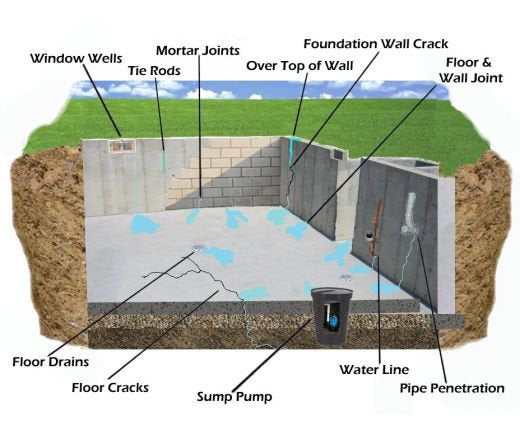
Negative Effects of a Leaky Basement
A leaky basement can ruin your home in so many different ways, but here is a list of the most common ways that flooding can affect your home and your daily routines:
- A leak in your home will eventually lead to flooding if it’s not taken care of right away. Any kind of water in your home will ruin your floors, carpets, wallpapers, furniture and any other belongings you may have stored in the affected areas.
- All kinds of bacteria can make their way into your home through a leak, that’s why it is important to disinfect the affected areas as soon as possible after drying out a flooded basement.
- Moisture creates a breeding ground for mold and that can create very hazardous health issues for your house and your loved ones. Some types of mold, such as toxic black mold can start to grow immediately after a flood.
- The process of trying to dry out your basement after a flood or a leak will raise the humidity in the room and the air will become very damp. The humidity will also linger because basements usually have poor ventilation and little to no sunlight. This can also contribute to more mold growth.
- The combination of sitting water in an unventilated room and humidity will cause a very unpleasant odor to make its way through your home.
- Basement flooding can ultimately ruin the structure and foundation of your home, which in turn can lead to more cracks in the cement, more leaks and more flooding.
- A leaky basement has the potential to not only lessen the physical appeal of your home, but it can also depreciate its value. This can make it hard to sell your home if you ever want to move. It can also make it hard to qualify for flooding insurance if your basement is prone to flooding often.
- Any kind of moisture in your basement can ruin drywall, framing and any kind of wood.
There are many other negative and dangerous side effects of a leaky basement.
Solve Leaky Basement Problems….For Good
Homeowners put a lot of money into making their home a comfortable and aesthetically pleasing living space. Many also invest in turning their plain basement into an extra guest room, home theater, and office space or entertainment center. Imagine the heartache of all your hard work and spent money floating around in a pool of murky water after a heavy storm.
Fortunately, there are solutions to leaky basements as well as preventive measures to help avoid unwanted water in your home and all the negative effects that accompany it.
Many people will rush to their nearest home improvement store at the sign of a leak and spend money on sealants and waterproof coatings. While this may be a good temporary solution, by the time the next heavy rain fall rolls around the leak will be back.
Triad Waterproofing has more than 27 years of experience with leaky basements and helping homeowners repair damage to their homes after an unfortunate flood in the basement. If you are worried about a leaky basement and the effects it can have on your home or if you just want to be cautious then contact one of our representatives and we can discuss any services that you may be interested in!
